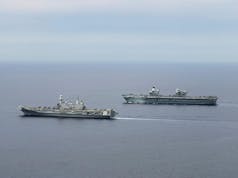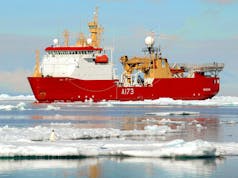The first of five new offshore patrol vessels, HMS Forth, is ready to be launched in Glasgow.
The semi submersible barge ‘Dina Launcher’ was towed to the Clyde for the launch of HMS Forth, arriving earlier today.
HMS Forth is a River class offshore patrol vessel under-construction on the Clyde. We’ve taken a closer look at her and the second vessel in the class, HMS Medway, as they near completion.
On the 6th of November 2013 it was announced that the Royal Navy had signed an Agreement in Principle to build three new OPVs based on the River class design at a fixed price of £348m including spares and support, an additional two vessels were outlined in the Strategic Defence & Security Review in 2015.
During a Defence Select Committee in July 2016, the First Sea Lord Admiral Sir Philip Andrew Jones indicated that the option for a fleet of ‘up to six’ offshore patrol vessels had been reduced to five, with Clyde being replaced by one of the new Batch 2 ships.
HMS Forth will launch this week.
The semi submersible barge ‘Dina Launcher’ is pictured here, ready to receive HMS Forth.

The First Sea Lord also elaborated on the potential uses for the Batch 2 ships overseas, including the possibility of forward basing an extra ship at the Falklands Islands, or forward basing it elsewhere. Admiral Sir Philip Jones said:
“Well, you are absolutely right that they have proved enormously useful, flexible and reliable ships. There are four vessels that we have in service at the moment. Three are Tyne, Mersey and Severn, which operate largely in UK waters on fishery protection and offshore tapestry protection, and of course they are increasingly working with the Border Force and the Maritime and Coastguard Agency in support of protection of UK waters. Then we have a fourth one, which is permanently based in the South Atlantic.
We have had those ships in service for quite some time now. We are looking at replacing them with slightly larger and more capable ships in due course anyway, so that was already in the course of production to bring three of those in. The additional two will enable us to take a longer term view of how we replace HMS Clyde, which is a slightly larger helicopter-capable version of the OPV. We are looking at a number of ways in which we might use the fifth one.
So, the fourth one is clearly a Clyde replacement.
The fifth one can either be added into the mix for the three that operate in UK waters or it could be forward-deployed somewhere else in the world, or it could become a second vessel operating in the South Atlantic. All those options are available.”
Pictured is ‘HMS Forth’ and one of her three sisters in an early stage of build.
Steel was cut on the 10th of October 2014 and they are expected to enter service starting 2017, with the last being delivered by the end of 2018.
The 90 metre OPV is based on a proven BAE Systems design which is already in service with the Brazilian Navy and Royal Thai Navy. BAE Systems have modified the design, ensuring it meets the requirements of the Royal Navy in support of UK interests both at home and abroad.
The programme has however been the focus widespread concern at the significantly increased cost of the Royal Navy variant.
The vessels will include a modified flight deck capable of operating Merlin helicopters, larger stores and more accommodation for embarked troops. They will also be the first ships to be built with a BAE Systems designed, new operating system called ‘Shared Infrastructure’, which will be rolled out across the Royal Navy surface fleet over the next ten years.
By replacing multiple large consoles dedicated to specific tasks with a single hardware solution, the amount of spares which are required to be carried on-board is reduced, significantly decreasing through-life costs.
The programme will sustain around 800 jobs on the Clyde and keep BAE yards ticking over over between work ending on new 70,600 tonne carrier HMS Prince of Wales and construction beginning on the first Type 26 frigates.
HMS Forth and her sisters will enter service from 2017.













Wait what happened to HMS First, Second and Third?
Do try harder
Good effort, but I agree with David.
Underarmed and undermanned.
Forth, on the Clyde? Has to be a joke in there somewhere…!
The joke is the price!
These are not just your standard OPVS Derek Haycock
I wonder if these ships could be up armed, should it be required.
The River Class were designed and built by VT Workers
Will the Navy pass the Old Rivers to our Border Force to help manage our Borders?
On what day and at what time will this happen? Can we watch a feed of it happening? Will you upload a time-lapse?
The launching barge is ‘Dina Launcher’ . Is this Scottish for Don’t launch her? Maybe they want to keep working on vessels endlessly with the lack of future worthwhile orders.
Looks good, still think adding a hanger, a 76mm gun and a 8 cell Mk41 for CAAMS (M) and provisions for NSM launchers would be a much better solution to current issues than the overpriced Type 26, you would be able to build twice the number for half the cost, and then look at replacing the Type 23 hulls with Type 26 once the numbers in service are back and the service isn’t at breaking point anymore.